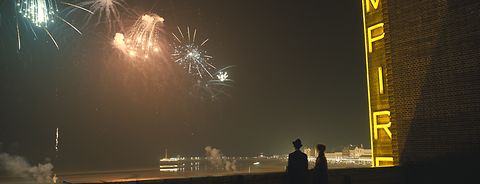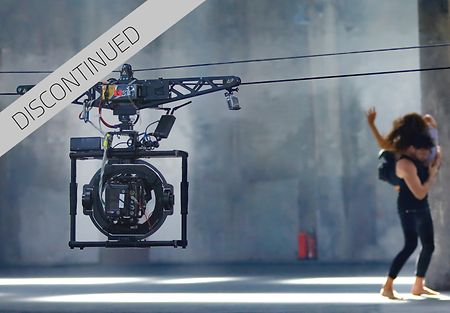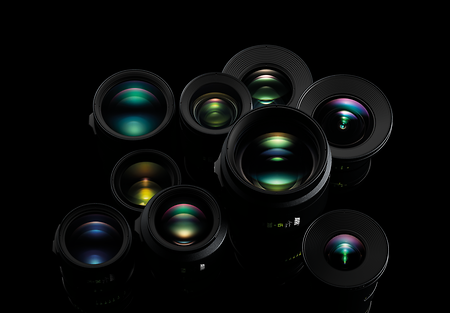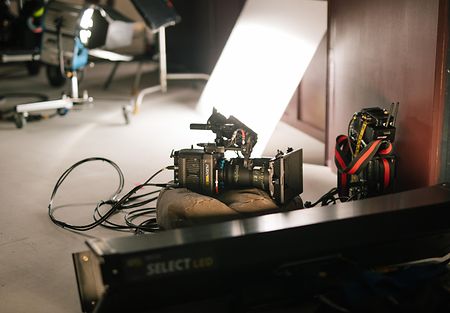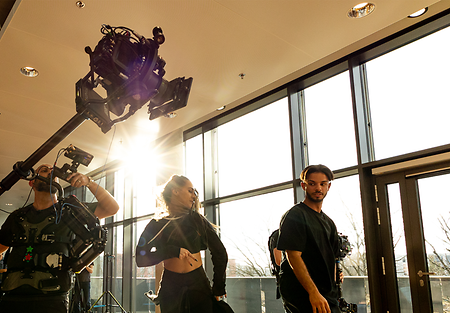Set in and around the cinema of a 1980s British seaside town and starring Olivia Coleman and Michael Ward, “Empire of Light” is the fifth movie collaboration between director Sam Mendes and DP Roger Deakins. On their previous film together, the WWI drama “1917,” Deakins shot with ALEXA Mini LF cameras and ARRI Signature Prime lenses, often mounting them on an ARRI TRINITY stabilizer to achieve smooth, continuous camera movement. On “Empire of Light” Deakins again chose the Mini LF and Signature Primes, but this time he turned to the MAXIMA three-axis stabilized gimbal, a collaborative product developed by FoMa Systems and exclusively distributed by ARRI. Key grip Gary Hymns speaks here about working with the MAXIMA, which was supplied to the production by Optical Support in the UK.
What general approach to camera movement did Roger and Sam pursue on this movie?
“Empire of Light” is a performance-driven film, concentrating more on dialogue, not having as many complex camera moves as “1917” or “Spectre,” the previous films I’d worked on with Sam. Actually, it was the opening scene of “Spectre” that gave Sam the idea of shooting “1917” as though it was a single shot, using the TRINITY stabilizer, but for “Empire of Light” he and Roger wanted a more classical approach.
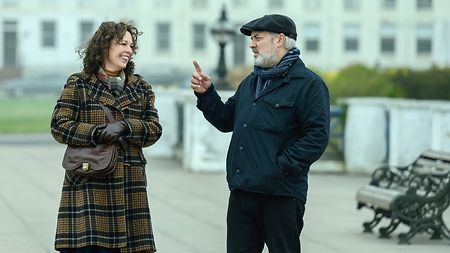
Director Sam Mendes (right) on location with actor Olivia Coleman.
Could you describe the testing you did with MAXIMA at ARRI Rental UK?
Testing the MAXIMA involved the camera and grip departments becoming familiar with a piece of equipment that we hadn’t used like this before. We found that for shots requiring me to carry and walk with the MAXIMA, the best results were achieved with me wearing a Steadicam vest and arm. We then tested long tracking shots in the ARRI car park, tracking over uneven ground where we could.
After various tests, such as hard mounting the MAXIMA on a PeeWee dolly with pneumatic wheels, we found that the best dolly system was hard mounting a Garfield on a rickshaw dolly and attaching a Steadicam arm, with me sitting on the dolly and holding the MAXIMA. We used this system throughout the film.
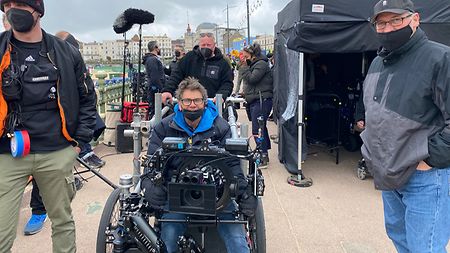
Key grip Gary Hymns seated in a rickshaw dolly, holding MAXIMA supported by Steadicam arm.
What are some of the specific scenes that you used MAXIMA for?
The MAXIMA was especially used for tracking shots along the seafront at Margate, both pushing from behind the actors and pulling while in front of them. For example, a long tracking shot of Olivia Coleman leaving the cinema and walking along the seafront—that was one where I was holding the MAXIMA on a rickshaw dolly, with A-camera dolly grip Paul Hymns tracking.
There was also a long and wide tracking profile shot of Michael Ward walking to Olivia’s flat. It was important that we maintained a level horizon, which was achieved with some help from rental technician Ben Hamill of Optical Support. That shot was me holding the MAXIMA with best boy grip Gary ‘Gizza’ Smith tracking.
Then there was the scene on a train, where we wanted to push in and drop down as Michael enters the train. Having no room for a dolly, track, or slider, we rigged a bazooka with the Steadicam arm and by mounting the MAXIMA to the arm, we managed a four-foot push-in with a one-foot drop.
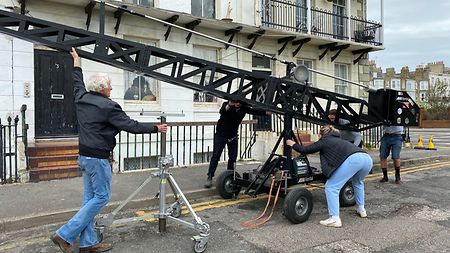
Cinematographer Roger Deakins (left) helping to move a crane on location.
Were there any other MAXIMA configurations that you used on the shoot?
There was a hospital scene where we followed Michael on a gurney from the ambulance to Accident and Emergency, using the MAXIMA rigged with a bazooka on a front-wheel steer dolly. We also wanted a POV shot from Michael’s perspective, so we rigged the MAXIMA on the gurney itself, with me lying on it.
Sometimes we rigged a five-foot length of 32 mm aluminum tube mounted to the top of the MAXIMA, enabling two people to carry it and walk over uneven ground or sand. An example of this configuration was the beach scene where Michael and Olivia are building sandcastles during a day out at Camber. For this scene it was me and Paul that were holding the tube and walking with it.
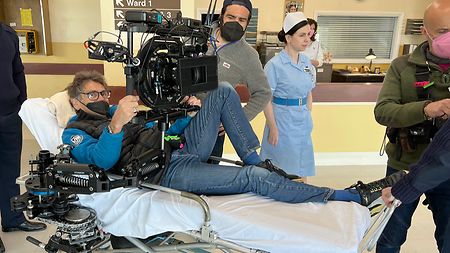
Gary Hymns lying on a hospital gurney for a POV shot filmed using the MAXIMA.
And who actually controlled the movement of the MAXIMA?
Roger operated the MAXIMA from remote wheels while I held it, and James Deakins relayed messages before and after each take. This was a system that we had developed with heads and stabilizers on “1917,” so we knew it worked well. 1st AC Andy Harris pulled focus, while 2nd AC Sam Irwin and Ben took care of balancing the stabilization. Paul and Gary tracked the dolly when we used one.
What were the key benefits of using the MAXIMA?
The benefits of using the MAXIMA were that it saved us time and made us more flexible, because you don’t have to spend time and resources laying long tracks or dancefloors. The MAXIMA worked really well for complex tracking shots, for example going from an exterior to an interior during the hospital scene. Being on a soft-wheeled dolly for that scene saved us a very complicated dancefloor build. And not having to spend money painting out dolly tracks in post must have pleased production!
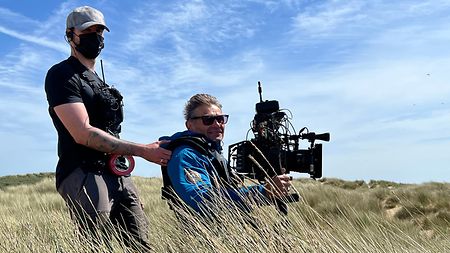
Gary Hymns (right) with MAXIMA and ALEXA Mini LF, supported by Ben Hamill.
